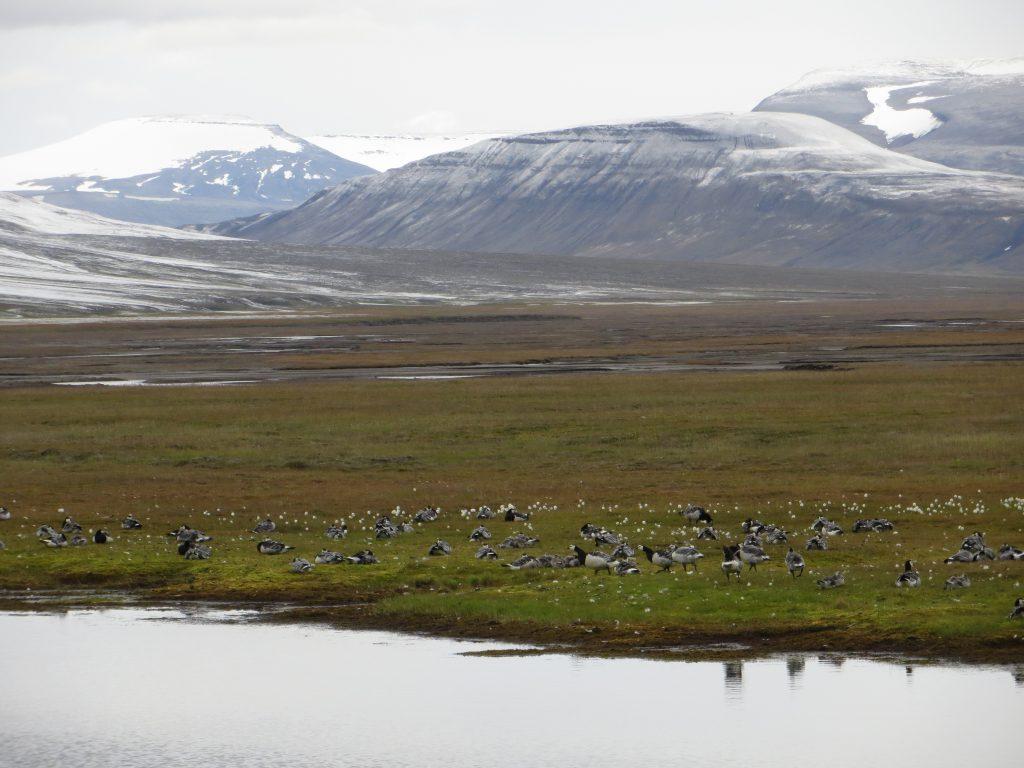Bryophytes have many important ecosystem functions in the Arctic. These include:
Regulation of hydrology
In many habitats, bryophytes control soil and vegetation hydrology (Beringer et al. 2001). This is mainly due to their large capacity to absorb and retain water. Especially Sphagnum is known for its capacity to retain water in both intra- and extracellular spaces, even defying gravity by capillary upward movement of water. Peatlands, for example, are able to maintain their own water table level this way, independent of outer topographical settings.
Regulation of soil temprature
Bryophytes act as an insulating layer above the soil (Gornall et al. 2007, Soudzilovskaia et al. 2013). In arctic habitats, bryophytes are thereby protecting permafrost. Changes from moss- to vascular plant-dominated flora can therefore have far-reaching consequences (more coming soon here).
Contribution to vegetation productivity
When comparing productivity between the tundra biome and more southern terrestrial biomes, the annual productivity is lowest in the tundra, if one excludes desert and semidesert areas (Glime 2007, see figure to the right). Even though the annual productivity of arctic tundra is generally low, great heterogeneity exists between different vegetation types.
The photosynthetic capacity of mosses is considered to be much lower than that of the vascular plants, but their overall contribution to vegetation productivity becomes more important in the Arctic, as their cover and diversity increase relative to vascular plants. Bryophytes can have a similar or higher annual net production compared to vascular plants (above ground biomass) in polar regions comparable to growth in boreal or temperate regions (Fenton 1980, Longton 1988).
Carbon storage
Since the end of the last glacial period, much of the Boreal and Arctic zones have been covered by peatland dominated by species from the genus Sphagnum. These peatland areas are important in providing crucial ecosystem services such as habitat maintenance, permafrost protection, water regulation, greenhouse gas exchange, primary production, and they serve as carbon sinks (CAFF 2010). The amount of carbon in northern hemisphere peatlands is 320 gigatonnes (320 x 10ˆ12 kg), about 44% of the amount held in the atmosphere as CO2 (Rydin and Jeglum 2006). Peat accumulation mainly occurs in the warmest lowlands of central Spitsbergen and in areas influenced by bird fertilisation. In Svalbard, Sphagnum species are not commonly distributed and only found within the Middle Arctic Tundra Zone. Additionally, other bryophytes contribute to peat formation in the Arctic, such as Tomenthypnum nitens, Calliergon sarmentosum, Aulacomnium turgidum, Sanionia uncinata and Bryum pseudotriquetrum.
Nitrogen fixation
Many cyanobacteria live epiphytically on moss leaves and between the stem and leaves of a number of different bryophytes. Moisture availability seems to affect nitrogen input into the system with bryophyte-cyanobacterial associations playing an important intermediary role in the process, as found for polar desert in Arctic Canada, thus having an indirect effect on ecosystem development (Stewart et al. 2011). In Svalbard, a study found that the period just after snowmelt, when the vegetation is saturated with water, is the most important in respect to nitrogen fixation for much of the vegetation (Zielke et al. 2005). In areas that remain wet through the entire growing season, nitrogen fixation is controlled by air temperature (Rousk et al. 2018).
Food source
Of the more than 60 bird species with conservation priority in the European Arctic, 75% are strongly associated with tundra and mire habitats. Geese are especially bound to these vegetation types. Even though vascular plant structures are preferred when available, bryophytes are a natural part of their diet especially during springtime. A study from Svalbard found that bryophytes make up more than 90% of the barnacle geese diet during spring (Stech et al. 2011).
Habitat for invertebrates
Bryophytes are also important habitats for the invertebrate fauna, providing shelter, moisture, nutrients and a stable environment (Gerson 1982). The invertebrate fauna is in turn an important contributor to arctic biodiversity, and provides key ecosystem services such as energy flow, decomposition, nutrient cycling and pollination.







